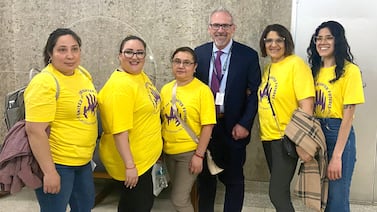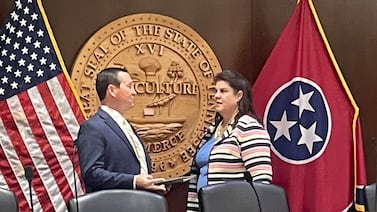“Hace muchos años, en una casita de balcón, una vez vivía una cucaracha española llamada Martina.”
That is the first line of the folktale that introduced bilingual storytime to the New York Public Library.
The tale? “Pérez y Martina.” The love story of a cockroach and a mouse. Told the exact same way the storyteller first heard it from her abuela in Puerto Rico: Many years ago, in a little house with a balcony, there lived a Spanish cockroach named Martina.
The storyteller? Pura Belpré, an Afro-Puerto Rican from the island and the first Latina to become a librarian at the New York Public Library.
In her honor, for the past 25 years the American Library Association has been granting the Pura Belpré Award to young adult and children’s literature that “allows Latinx children to see themselves represented, and for all children to see Latinx protagonists in their books.” But the history of how she ended up at the 115th Street branch and her contributions to the city’s public library system are not always taught to younger generations.
Belpré was born and raised in Puerto Rico. In 1920, she came to New York City for her sister’s wedding and never went back. In 1921, Belpré was hired by the 135th Street branch of the New York Public Library as an “Hispanic Assistant,” a position created to serve the increasing Spanish-speaking population of Harlem. In 1929, she was assigned as a librarian to the 115th Street branch.
“Pérez y Martina” is one of many Puerto Rican folktales passed down from generation to generation, or as Belpré would say, corre de boca en boca. Belpré carried puppets and other props all over New York City to not only tell the story of “Pérez y Martina,” but to perform the story.
But it was at the branch at 203 W. 115th St. where Belpré introduced bilingual storytelling, puppet performances, and celebrations of El Día de Reyes (Feast of the Three Kings). She successfully attracted the Puerto Rican community to the library, especially children. And on the second floor of the library, in the children’s room, “Pérez y Martina” fell in love multiple times a year.
Today, the 115th Street branch, also known as the Harry Belafonte branch, still hosts storytime. But since the COVID-19 pandemic started in March of 2020, storytime takes place on Zoom more often than in-person. And as many Spanish speakers moved to East Harlem, Washington Heights, or the Bronx, storytime is now held only in English.
A black-and-white photograph of her storytelling is displayed on the second floor alongside other photographs of the library in its infancy. A picture book about her life is displayed in the children’s autobiography section. Written by Paola Escobar and illustrated by Anika Aldamuy Denise, the book is entitled Planting Stories: The Life of Librarian and Storyteller Pura Belpré. It tells the story of Belpré’s life from her birth as Pura Teresa Belpré y Nogueras in 1903 in Cidra, Puerto Rico, to her death in 1982 in Washington Heights.
When asked what Belpré thought of children, in a 2021 short documentary about her work, her best friend Elba Cabrera said: “El futuro.” The future. “I believe that, for her, writing books for children was the greatest thing in the world.”
“Pérez y Martina” was the first Latin American folktale to be published by the U.S. mainstream press. It was also the first one published in Spanish. This was in 1932, when many marginalized communities didn’t see themselves represented in the library.
Today, at face value, most branches of the New York Public Library seem as diverse as New York City. However, in a more segregated New York of the early 1900s, librarians of color were sent to Harlem because Harlem had the “colored” branches.
That was the case for one of Belpré’s colleagues at the 115th Street branch, Regina Anderson Andrews. A 22-year-old Chicago native, Andrews applied for a librarian position at the 42nd Street branch and was told she was not an American. “We’ll have to send you to Harlem,” her interviewer told her.
Little did they know that Harlem would do Andrews well. She became the first Black person to hold the position of Supervising Branch Librarian. Throughout her time, she invited prominent figures and writers to speak at the library, including Franz Boas, Eleanor Roosevelt, and Langston Hughes. But it wasn’t an easy journey.
W.E.B. Du Bois, who was then the head of the National Association for the Advancement of Colored People, advocated for Andrews when the New York Public Library refused to award her a deserved promotion. In solidarity, the community protested and boycotted the library.
In 1938, Andrews was promoted to Supervisor Branch Librarian at the then Andrew Carnegie 115th Street branch. In her papers at the Schomburg Center for Black Culture, in Harlem, an unidentified newspaper cutout says, “To Mrs. Regina Andrews of New York City goes the distinction of being the first Negro to be placed in full charge of a public library branch in the city of New York.”
Today, when librarians at the 115th Street branch are asked about Belpré, they all know who she is. The same isn’t true for Andrews.
The two women’s time at the 115th Street branch overlapped for only a year. Andrews arrived in 1938 and Belpré was transferred out to the 110th Street Aguilar branch in 1939. Their history is the history of the Harlem branches. Of Harlem. Of the changing movements of people of color in New York City. Of struggle and solidarity between Black Americans and Puerto Ricans.
After a decade of bringing Spanish speaking activities and literature to the library, Belpré was transferred to East Harlem, following the movement of Spanish-speaking communities heading east and north.
In 1982, the year she died, Belpré received a Lifetime Achievement Award from the New York Public Library. And every year since 1996, the American Librarian Association has given out the Pura Belpré Award to outstanding works of literature by Latino authors.
In 2021, the Pura Belpré Award celebrated its 25th anniversary. In a short documentary made for the occasion, Senior New York Public Library Librarian Valerie Garcia said, “Her presence is there when people come in, when children meet after school, when parents schedule playdates at the library. I believe that that’s Pura’s spirit making the library a community place where people feel comfortable and they feel safe and they want to come back.”
Marcele Rodrigues-Sherley was a reporting intern for Chalkbeat New York. She is a reporting fellow at the Chronicle of Higher Education.








